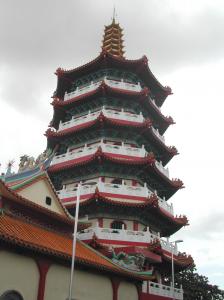Pagoda
|
|
A pagoda is the general term in the English language for a tiered tower with multiple eaves common in China, Japan, Korea, and other parts of Asia. Most pagodas were built to have a religious function and served as temples, most commonly of the Buddhist faith.
It is believed that the original pagoda design originated among the Newar of Kathmandu Valley, Nepal. Since then, the architectural structure has spread across Asia, taking upon many diverse forms as details specific to different regions are incorporated into the overall design.
Pagodas attract lightning strikes because of their height. This tendency may have played a role in their perception as spiritually charged places. Many pagodas have an antenna at the top of the structure known as a finial. This antenna is designed in such a way as to have symbolic meaning within Buddhism; for example, it may include designs representing a lotus. The finial also functions as a lightning rod, and thus helps to both attract lightning and protect the pagoda from lightning damage.
Derivation of word
The derivation of the word "pagoda" is uncertain, with different sources claiming different derivations. The earliest example in the Oxford English Dictionary of the use of the word pagoda in English is from 1634.
According to Alain Rey's Dictionnaire historique de la langue française (rev. ed. 1995), the word first appeared in French as pagode in 1545, meaning "temple of an Eastern religion" and deriving from a Portuguese word dated from 1516. The derivation is uncertain. Possible roots are the Dravidian pagodi or pagavadi, a name of Kali derived from the Sanskrit bhagavati ("goddess"), and the Persian butkada ("temple").
According to Liang Ssu-Cheng's A Pictorial History of Chinese Architecture (MIT Press, 1984), the word pagoda is derived from the Chinese 八角塔 (in pinyin, bā jiǎo tǎ, hence "pagoda"), meaning literally "eight-cornered tower." Pagodas with an octagonal base were an extremely popular pagoda design in the late Ming Dynasty and early Qing Dynasty periods when Europeans were coming into contact with China.
In the 18th century, Chinoiserie, a style based on Chinese and other Far East designs became popular in Europe, introduced by the burgeoning trade and travel routes. An example of this is the pagoda in Kew Gardens, England, which was completed in 1762 as a gift for Princess Augusta, the mother of George III. In an unexpected twist, a "pagod" became the English name in the luxury trade for a porcelain figure of a Chinese seated god.
Some famous pagodas
- An Quang Pagoda, a meeting place for Vietnamese Buddhist leaders in Saigon, and site of the Institute for Dharma Propagation.
- Most pagodas with a religious function are Buddhist stupas; however, the Daqin Pagoda in China was an exception, being built by early Christians.
- Jade Chop Pagoda in the Three Gorges region of the Chang Jiang (Yangtze) river.
- Miruksa Temple Pagoda at Iksan of Chollabuk-do province in the Republic of Korea, a Paekche pagoda mid 5th century.
- Toji, the tallest wooden structure in Japan.
- Porcelain Tower, a wonder of the medieval world in Nanjing.
External links
- http://www.sogang.ac.kr/~anthony/Korea/Pagodas.htm
- http://www.orientalarchitecture.com/kyongju/bulguksaindex.htmbn:প্যাগোডা
de:Pagode eo:Pagodo fr:Pagode ko:탑파 nl:Pagode ja:仏塔 pl:Pagoda pt:Pagode (templo) sv:Pagod zh:塔


